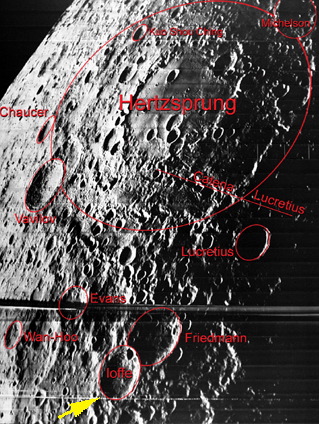Difference between revisions of "April 26, 2004"
| Line 25: | Line 25: | ||
NSDC reported that the crash site was at 229 degrees east, but nowadays coordinates go only to 180 E and oppositely to 180 W. I assume that 229 E equals 130 W.</p> | NSDC reported that the crash site was at 229 degrees east, but nowadays coordinates go only to 180 E and oppositely to 180 W. I assume that 229 E equals 130 W.</p> | ||
<p class="story"><b>Related Links:</b><br>[http://nssdc.gsfc.nasa.gov/database/MasterCatalog?sc=1962-012A Ranger 4 at NSSDC]</p> | <p class="story"><b>Related Links:</b><br>[http://nssdc.gsfc.nasa.gov/database/MasterCatalog?sc=1962-012A Ranger 4 at NSSDC]</p> | ||
| − | <p | + | <p><b>Yesterday's LPOD:</b> [[April 25, 2004|Ortho Atlas]] </p> |
| + | <p><b>Tomorrow's LPOD:</b> [[April 27, 2004|A Penetrating View of Imbrium]] </p> | ||
</td></tr> | </td></tr> | ||
</table> | </table> | ||
Revision as of 12:47, 1 February 2015
America Hits the Moon!
Image Credit: LO V-26-H3 Lunar & Planetary Institute |
|
America Hits the Moon! On Sept. 13, 1959 the Soviet Union crash landed the Luna 2 probe onto the Moon - the first thing from Earth to contact another planet. The US followed with a crash onto the lunar surface on April 26, 1962, 42 years ago today. Our Ranger 4 probe was supposed to crash land on the nearside of the Moon, taking images all the way to the surface. But an equipment failure 10 hours into the mission resulted in the spacecraft hitting the lunar farside at 229.3 degrees E, 15.5 degrees S at 9600 km/hr. The yellow arrow on the image above (from the Lunar & Planetary Institute online Lunar Orbiter Atlas of the Moon) shows where Ranger 4 is thought to have hit near the crater Ioffe. This Lunar Orbiter V image is the best view extant of this area, but the horizontal black line/defect shows that there is still a great need for high quality imaging of the farside! Also, did you notice that the red arc marking the southern end of the Hertzsprung impact basin is in the wrong place? The basin's rim is about 0.5" (on my monitor) to the south of the red arc. Technical Details: Related Links: Yesterday's LPOD: Ortho Atlas Tomorrow's LPOD: A Penetrating View of Imbrium |
Author & Editor:
Charles A. Wood
COMMENTS?
Register, and click on the Discussion tab at the top of the page.
Contributions to http://www2.lpod.org/ are licensed under a Creative Commons Attribution No-Derivative-Works Non-Commercial 3.0 License. 




